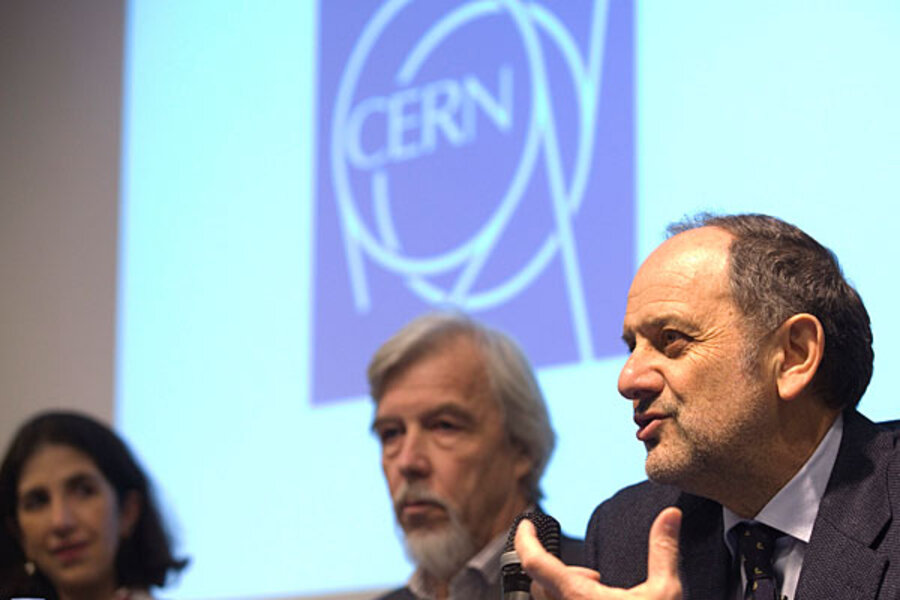Higgs boson: Physicists close in on the 'God particle'
Loading...
In the search for what some have dubbed the "God particle," physicists have gotten a whiff of something interesting, but they aren't close to claiming discovery yet.
The quarry: the Higgs boson, a subatomic particle associated with a universal field permeating space that imparts mass to other particles as they encounter it.
At a two-hour seminar at the European Center for Nuclear Research (CERN) in Geneva Tuesday, two groups using independent means for seeking the Higgs boson reported seeing tantalizing hints of the Higgs' presence.
But the data were barely distinguishable from the signals one could expect from random noise.
"What we see right now is in agreement with what you would expect if there is a Higgs, or if there is not – the data are in agreement with both at this point," says Pauline Gagnon, a senior research physicist with Indiana University at Bloomington and currently at CERN.
Yet both groups saw their faint signals in multiple channels their detectors cover and within the same narrow range of masses.
"That's where it becomes interesting," Dr. Gagnon says.
It's as though two breeds of hunting dogs caught the same faint scent, just enough to send them baying down the same trail.
The Higgs field represents an explanation to a problem that has bedeviled physicists for some 50 years, notes Boston University physicist Lawrence Sulak: how particles acquire mass.
"The proton is 2,000 times heavier than an electron" he explains. "No one has the slightest idea why."
Until the particle is discovered, the Higgs-field explanation remains largely theoretical. Other groups have tried to find the Higgs boson using less-powerful particle accelerators than the one researchers are using at CERN.
Those efforts succeeded in reducing the range of masses one could expect the Higgs boson to exhibit. But no one has yet had the Eureka! moment.
That narrowing of the hunting ground led CERN's director-general Rolf-Dieter Heuer to declare, "The window on the Higgs mass gets smaller and smaller."
The two teams' data were gathered at CERN's Large Hadron Collier, a circular proton collider designed to accelerate bunches of protons in opposite directions to nearly the speed of light.
Once the bunches are accelerated to the very high energies, they are magnetically steered toward collisions within the hearts of massive detectors. From the subatomic collision debris the detectors track, physicists can reconstruct far heftier particles the collisions fleetingly create.
Gagnon notes that the type of Higgs boson physicists are first seeking – the one for which they may have seen hints as reported Tuesday – is only one of several possible versions of the Higgs boson.
The target of the current search is associated with the Higgs field, a mechanism three independent groups of physicists proposed in the 1960s to resolve a discrepancy between the predicted masses of two other types of bosons and their measured masses. Theory said 0. Detection and measurements said "heavy."
The Higgs mechanism and its associated boson are named for one of the physicists proposing the phenomenon, Peter Higgs.
But the Higgs boson that was the subject of Tuesday's seminar is the version associated with the so-called standard model – a description of three groups of fundamental particles, their traits, and their interactions.
Newer theories, such as supersymmetry, attempt to move beyond the standard model and posit an additional four forms of the Higgs boson, all heavier than the one tied to the standard model, Gangon says.
So even if the evidence for a standard-model Higgs turns out to be ephemeral, there may be heavier versions left to hunt.
Based on Tuesday's results and the better-than-advertised performance of the Large Hadron Collier, however, some researchers say with more collisions from CERN's 17-mile-circumference collider during 2012, enough evidence to claim discovery could well accumulate.
The hints reported Tuesday "could turn into proof beyond a doubt come next October," writes Dr. Sulak in an e-mail exchange.





